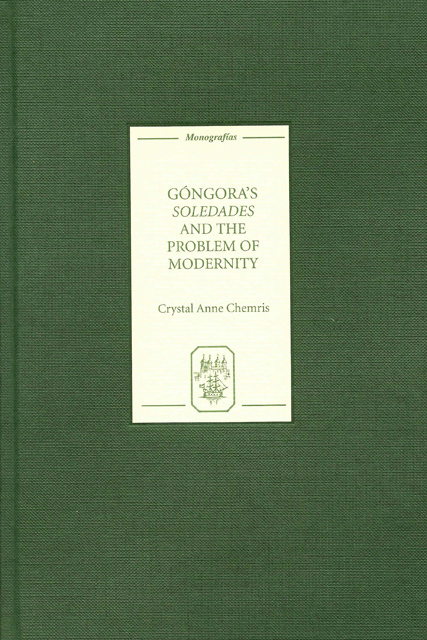Book contents
- Frontmatter
- Contents
- Dedication
- Foreword
- Acknowledgments
- Preface
- Introduction: Renaissance and Solitude
- 1 Crisis and Form
- 2 Violence, Eros and Lyric Emotion
- 3 Self and World: The Crisis of Perception in the Soledades
- 4 Time, Space and Apocalypse: The Falconry Scene as Disruption of Prophecy
- 5 Góngora and the Modern: “New Poetry”?
- Works Cited
- Index
5 - Góngora and the Modern: “New Poetry”?
Published online by Cambridge University Press: 03 May 2023
- Frontmatter
- Contents
- Dedication
- Foreword
- Acknowledgments
- Preface
- Introduction: Renaissance and Solitude
- 1 Crisis and Form
- 2 Violence, Eros and Lyric Emotion
- 3 Self and World: The Crisis of Perception in the Soledades
- 4 Time, Space and Apocalypse: The Falconry Scene as Disruption of Prophecy
- 5 Góngora and the Modern: “New Poetry”?
- Works Cited
- Index
Summary
Pasos de un peregrino son errante cuantos me dictó versos dulce Musa, en soledad confusa perdidos unos, otros inspirados.
Luis de GóngoraFable
Par ce mot par commence donc ce texte
Dont la première ligne dit la vérité.
Mais ce tain sous l’une et l’autre
Peut-il être toléré?
Cher lecteur déjà tu juges
Là de nos difficultés. …
(APRÈS sept ans de malheurs
Elle brisa son miroir.)
Francis PongeIf the ontological crisis of the Baroque has been identified with the first stirrings of the modern, it is not surprising that the Soledades, in its expression of this crisis, announces some of the problems of modern poetics. Góngora's creation of a “new poetry” has linked him to aesthetic modernity, and this connection can be studied from a variety of angles; the most obvious approach has been to study the revival of Góngora by the Generation of 1927. The influence of Góngora on this circle of poets has been adequately examined in Elsa Dehennin's major study La résurgence de Góngora et la génération poétique de 1927, and I have no intention of attempting to further develop that topic. The specific question of Góngora's influence could also be examined by surveying the well recognized use of his work by contemporary Latin American writers as part of the historical phenomenon of Neobarroquismo, an ebullient assimilation of Baroque aesthetics associated with Cuban writers and their disciples in the 1960s and 1970s. Beverley has cited the influence of the Soledades in particular in the writings of Lezama Lima, Gabriel García Márquez, and Alejo Carpentier, noting that Góngora's appeal to these writers can be explained in part by their identification with a moment of political crisis similar to their own. Yet my intention is not to trace Góngora's influence along the anticipated trajectory into the Neobaroque, but to examine the function of the avant garde appropriation of Góngora within a series of examples from twentieth-century Latin American poetry, elaborating in the process a problematic of historicism, aesthetics and modernity.
- Type
- Chapter
- Information
- Góngora's Soledades and the Problem of Modernity , pp. 104 - 142Publisher: Boydell & BrewerPrint publication year: 2007



